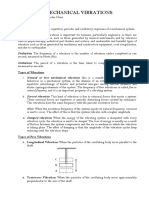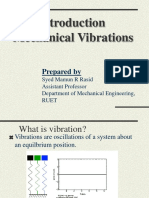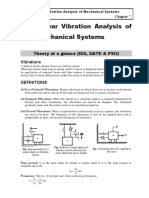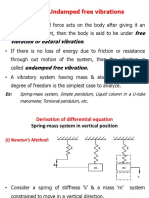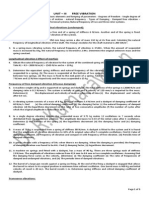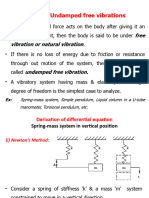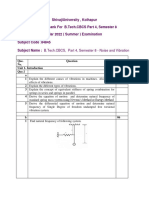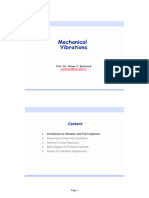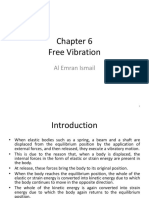0 ratings0% found this document useful (0 votes) 58 views14 pagesChapter 2
Copyright
© © All Rights Reserved
We take content rights seriously. If you suspect this is your content,
claim it here.
Available Formats
Download as PDF or read online on Scribd
Mechanical Vibration
CHAPTER 2: Free Longitudinal Vibration
Longitudinal vibration: If the particle of the shaft moves parallel to the axis of the shaff, then
the vibration is longitudinal vibration
2.1 Modelling of Dynamic Systems
Modelling of dynamic systems is the process of creating a mathematical representation of a
ie. Dynamic systems are systems that
change over time, and they can be found in many fields.
Modelling Techniques
There are many different modelling techniques that can be used to model dynamic systems.
‘Some of the most commoa techniques include:
Ordinary differential equations (ODEs): ODEs are mathematical equations that
describe how the rate of change of a system's variables depends on the current state of
the system, ODEs are a powerful tool for modelling dynamic systems, and they can be
used to model a wide variety of systems.
Partial differential equations (PDEs): PDEs are similar to ODEs, but they describe the
rate of change of a system's variables at different points in space, PDEs are more
complex than ODEs, but they are necessary for modelling systems that have spatial
dependence.
State space models: State space models are a type of model that represents a system as
a set of state variables and a set of input-output relationships. State space models are a
powerful tool for modelling dynamic systems, and they are often used in control
systems engineering
Modelling Process
‘The modelling process for dynamic systems typically involves the following steps:
ii,
iii,
Identify the objective of the model, What do you want the model to be able to do?
Develop a conceptual model. A conceptual model is a qualitative description of the
system and its behaviour.
Develop a mathematical model. This involves writing down the equations that describe
the relationships between the system's variables.
KeyruS.�Mechanical Vibration
iv, Solve the mathematical model. This can be done analytically or numerically.
v. Validate the model. This can be done by comparing the model's predictions to
experimental data,
2.2 Undamped Free Longitudinal Vibration
For the proper design of machine or machine parts which are subjected to vibration, it is
essential to estimate their natural frequencies to avoid resonance. The natural frequency of free
longitudinal undamped vibration can be found by applying Newton's second law to the free
body diagram of the vibrating mass. Consider a spring with spring constant k in Figure 2.1
The spring is in unstrained position initially without carrying a mass. When a mass m is
supported by the spring, due to the weight of the mass the spring tends to stretch a displacement
of 6 (static deflection). TI
leads for the system to obtain it equilibrium position. At this
position, the spring force will be balanced by the weight. Further application of any force to
displace (move by x) the mass results in an extra force in the spring which can return the mass
to equilibrium position,
&
:
Equilibrium, Fp = x5 kext)
poston —t at
W= me = m+
motion
me of body
®) Spring in by Spring inc) FBD of tho) Displaced
unstrained strained mass at equilibrium postion
position position position
Figure 2.1 Mass-Spring system at different position
At equilibrium position, applying Newton’s second law to the FBD,
mg kd =0
(2.1]
Acceleration a of the mass is always towards the mean/equilibrium position and given in terms
of displacement x a5
KeyruS. 2�Mechanical Vibration
ae
At displaced position, applying Newton’s second law to the FBD,
mg —K(x+6)=ma
=> mg —ke—kS = ma
> ma+ke=0 since mg=kd
sA22]
Equation 2.2 is the governing equation of free undamped longitudinal vibration of SDOF
system,
From the fundamental equation of SHM,
Comparing the two equations,
seeef2.3]
Where a is the circular frequency of the system
Natural frequency fi is
Since mg = kd,
KeyruS. 3�Mechanical Vibration
Jt ALS le
I if iE
0.4985
Hz
The time period f, is
25]
Since mg = kd,
Example 2.1
Stiffness of a closely coiled spring is 9.2 N/mm. Find the natural frequency of longitudinal
vibration of a mass of 17.5 kg hung from it,
Given data; k=9.2N/ mm, m=17.5kg
Required: f,
‘Solution; The natural frequency is
A [EL 1 [925107 _ 5 g4ore
2aV\m ln 17.5
A shaft of 100 mo diameter and | m long is fixed at one end and the other end carries a fly
Example 2.2
wheel of mass I fon. Taking young’s modulus for the shaft material es 200 GPa, find the natural
frequency of longitudinal vibrations.
KeyruS. 4�Mechanical Vibration
=0.lm,1= 1m, m= 1 tone = 1000 kg & E = 200 GPa
Given data; d,
Require 2
Solution; The static deflection (5) of a shaft of cross-sectional area d subjected to weight Wis
— Mala 1000498 245.10%m
AE AB pe 29 20010"
4 4
Then the natural frequency is
0.4985 0498599 gry
v5 ¥6.245x10°
Example 2.3
Spring-mass system has spring stiffness of k and a mass of m. It has the natural frequency of
longitudinal vibration as 12 Hz. An extra 2 kg mass is coupled to m and the natural frequency
reduces by 2 Hz. Find the value of k and m.
Given data, f,, =12Hz ard fi =\0Hz
Required; k=? and m=2
Solution; The first natural frequency
ae
22 Vm
Sn
=> k= 5684.89
Jk 19
m+2
=> k= 3947.84(m+2)
The second natural frequency
fh
ln
Combining the two equations,
=> k—25,840N / mand = m — 4.545kg
Example 2.4
Steel wire (E= 196 GPa) is of 2 mm diameter and is 30 m long. It is fixed at the upper end and
KeyruS. 5�Mechanical Vibration
carries a mass m at its lower end. Find the value of the mass so that the natural frequency of
longitudinal vibration is 4 Hz.
Given data; d= 2mm =0002m, 1=30m, f,=4Hz and E=196 GPa
Required; m=?
‘Solurton; The natural frequency is
ees)
Ve
= 6 =0.01553m
But the static deflection (4) of a shaft is
WL _mgl__mgl____mx9.81%30
ee Ue 7 2.002" 196%10"
= mee = 0.01553
a 19610"
4
= m=32.49%kg
2.3 Determination of Equivalent Stiffness of Springs
So far, we have discussed a system having only one spring. But in practice springs in series
and springs in parallel are mostly used. In order to find the natural frequency of such systems
ess of dhe system.
fast we nved to determine equivatent sti
2.2.1, Springs in Series
Figure 2.2 shows springs in series. Each spring is subjected to the same load applied at the end
of one spring. It can be noted that the total deflection of the assembly is the algebraic sum of
the deflection of each spring,
Figure 2.2 Springs in Series
KeyruS.�Mechanical Vibration
5=5 468,
www
pies
Kk;
2.6]
Therefore, the reciprocal of equivalent stiffiness of spring assembly in series is the sum of the
reciprocal of individual stiffness of the springs.
2.2.2, Springs in Parallel
Figure 2.3 shows springs in parallel. In this ease the deflection of each spring is the same. It
can be noted that, the load applied on the assembly is shared by the two springs.
m 7m
Figure 2.3 Springs in Parallel
W=W a,
Sh S=hd+ks
= hy =k +h, 2.7]
Therefore, equivalent stiffness of spring assembly in parallel is the sum of individual stiffness
of the springs.
Example 2.5
Determine equivalent spring stiffiness and natural frequency of the vibration systems shown in
Figure 2.4 (a) to (e). Whea
a) The mass is suspended by the spring
b) The mass is suspended at the bottom of two springs in series
©). The mass is fixed in between two springs
4d) The mass is fixed :0 the mid-point of a spring and
€) The mass is suspended at the bottom of two springs in parallel
Take k, =1S00N /m, k,=900N )m and m= 12 kg
KeyruS. 7�Mechanical Vibration
(@),
ki
Figure 2.4 Spring Assemblies
Given data; k, =1500N /m, k, =900N /m and m= 12 kg
Required; k,, = and f,
Solution;
a) The mass is suspended by the spring
= 1500N / m, thus
ae cL [1500 = rene
24Vm 2nV 12
b)_ The mass is suspended at the bottom of two springs in series
te
eee
k, 1500 900
62.5 m.thus
i
AL [ha 1/5625 1 ggon2
22Vm 2xV 12
©) The mass is fixed in between two springs
In this case the spring forces
and the mass.
lI be different but the deflections will be the same for the springs
KS Hh +k oS
ky =k tk,
=k, = 2400N /m,thus
Jo~sh fhe LPH asin
2aVm 22V 12
4) Spring stiffness is inversely proportional to the number of coils. Thus, the stiffness of
spring on each side of the mass is 2k. Now
k,, = 2k, + 2k, = 4k,
KeyruS. 8�Mechanical Vibration
= k,, = 6000/ m, thus
Fk,
cL |B — 1/6000 _ 9 score
2nVm 22V 12
©) The mass is suspended at the bottom of two springs in parallel
ky =k +k,
= k,, = 2400 /m,thus
f, JT [kay _ 1 [2400
"“2nVim 2aV 12
Determine equivalent spring stiffiness and natural frequency of vibration of the system shown
in Figure 2.5. Given that = 5000N /m, k, =k, =8000N /'m and m =25 kg.
2.25Hz
Example 2.6
Figure 2.5
Given data; k, = 5000N /m, k, =k, =8000N /m and m= 25 kg
=?and f,=
Solution; Springs 2 and 3 are connected in parallel. Thus, their equivalent stiffness is
ky, = ky +k; = 8000 +8000 = 16000N / m
Now spring | and equivalent spring 23 are in series, equivalent stiffness of the overall assembly
is
5000" 16000
1 fk
fk [3809.52
ae as = 1.965He
2aVm dV 25
KeyruS.�Mechanical Vibration
Example 2.7
For the system shown in Figure 2.6, k,
00N /m, k,=1500N /m, k, =3000N /m and
k,=2000N/m.
ind the mass m such that the system has a natural frequency of 6.75 Hz.
Figure 2.6
Given data; k,=k,=500N/m, k,=1S00N/m, k,=3000N/m, k,=2000N/m and
f, =6.15Hz
Required; m
Solution; Springs 1, 2 ané 3 are connected in series. Thus, their equivalent stiffness is
+ a
Kk, 500 500 1500
=214.286N/m
Shs
Springs 4 and 4 are connected in parallel. Thus, their equivalent stiffness is,
yg =k +h, = 3000+ 2000 = S000! m
Since the mass is in between spring 123 and spring 45. Thus, equivalent stiffness of the
assembly is
Kg = fas + hay = 214.286 + 5000 = 5214.286NV J m, thus
Kk,
ab fhe
SEV m
ky $214,286
m= 5 = 2h 286
(24 fF, (24*6.75)
899g
KeyruS. 10�Mechanical Vibration
2.4 Damped Free Longitudinal vi
23.1. Damping
In actual practice there is always internal or external resistance, such as air and mechanical
resistances, due to which the energy possessed by a vibrating body is gradually dissipated and
the body finally comes to rest in its equilibrium position. At the start of the vibratory motion
the amplitude of vibration is maximum which goes on decreasing and finally it is vanished
completely. This diminishing of vibration with time is called damping. The rate of decreasing
amplitude depends on the amount of damping. The device used for resistance of a vibratory
motion is damper (dashpot). Usually, damping force is proportional to velocity across the
damper. Dampers are used to control the amplitude of vibration so that failure due to resonance
may be avoided.
Damping can be achieved by any of the following types of damping.
a) Viscous damping
b) Coulomb or dry friction damping
©) Solid or structural damping and
4) Slip or interfacial damping
Damping force is proportional to velocity across the damper. The proportionality constant is
damping coefficient (c) which is damping force per unit velocity.
Damping force = exvelociry= ex St
t
ramping force
velocity
=c= 2.8]
Dampers in Series: When dampers are combined in series, the reciprocal of the equivalent
damping coefficient is the sum of the reciprocal of the individual damping coefficients.
+29]
a ™
Figure 2.7 Dampers in Series combination
KeyruS. i�Mechanical Vibration
Dampers in Parallel: When dampers are combined in parallel, the equivalent damping
coefficient is the algebraic sum of the individual damping coefficieats.
$0,460 [2.10]
Figure 2.8 Dampers in Parallel combination
2.3.2. Frequency of Damped vibration
Consider a mass-spring-dashpot system in Figure 2.9. The mass is suspended by a spring and
a dashpot is provided between the mass and fixed support. When the mass is forced to displace
trom equilibrium position, a resistance force will be developed both in the spring and dashpot
‘The damping force is proportional to the velocity of the mass, The spring force due to static
deflection will be balanced by the weight of the mass, so that both of these forces are avoided
from the FBD of mass at displaced position. This is because at equilibrium position, the forces
acting on the mass are only spring force and weight. As the velocity of mass is zero, the
damping force will be zero.
‘ de
nord
at
i
EFF mation
of bouly
a) Strained b) Displaced ©) FBD of the mass at
position position displaced position
Figure 2.9 Mass-spring-dashpot system,
At displaced position, applying Newton’s second law to the FBD,
nol ee ma
dt
KeyruS. 12�Mechanical Vibration
mareX + ke=0
dt
2.11]
Equation 2.11 which is second order linear ordinary differential equation is the governing
equation of free damped longitudinal vibration,
The characteristic equation of the governing equation is
Now, the solution for the governing equation is the displacement equati
which is
x(t)= de% + Be
«f=y=} “(ye
eoaad le *t mde Win) =}
Critical damping coefficient
[2.12]
Critical damping coefficient (c,) is the value of damping coefficient for which the radical
term (<) = Jin the above equation is equal to zero.
2m m
[2.13]
Oreven ¢,
2k
KeyruS. 13�Mechanical Vibration
Damping ratio or Damping factor (¢)
Damping ratio is the ratio of actual damping coefficient to the critical damping coefficient,
[2.14]
From the values of the roots
ese seceeeeeeeend2.15]
Ife > ccorg > 1, then the system is said to be over-damped
Ife = ccor ¢ = 1, then the system is said to be critically damped
Ife 1)
When ¢ > 1, the system is over-damped (large damping) and the solution of the system is
given by Equation 2.15 as
[eSp
PsP, a
x(t)=4el
This system cannot vibrate due to over-damping, Since both the roots are negative, the
magnitude of displacement approaches to zero bur it takes an infinite time to come to
equilibrium position. This type of motion is known as aperiodic motion.
Critically damped system (¢ = 1)
When ¢ = 1, the system is critically-damped. In this ease the charceteristic equation has only
one solution, 4 =—c, . Thus, the general solution for displacement equation becomes
x(t)=(4+ Be" 2.16]
This system also cannot vibrate and the displacement approaches to zero at infinity. Compared
to over-damped system, the displacement of critically-damped system approaches to zero
quickly
KeyruS. 14

